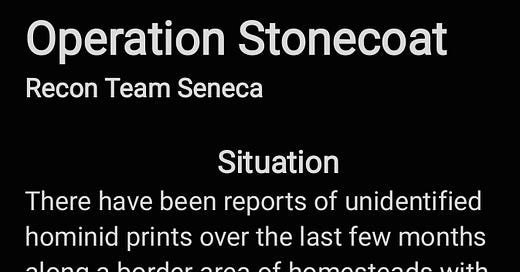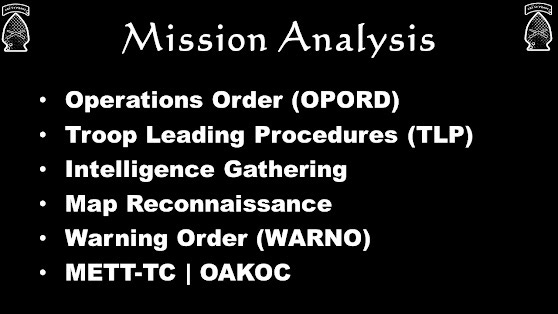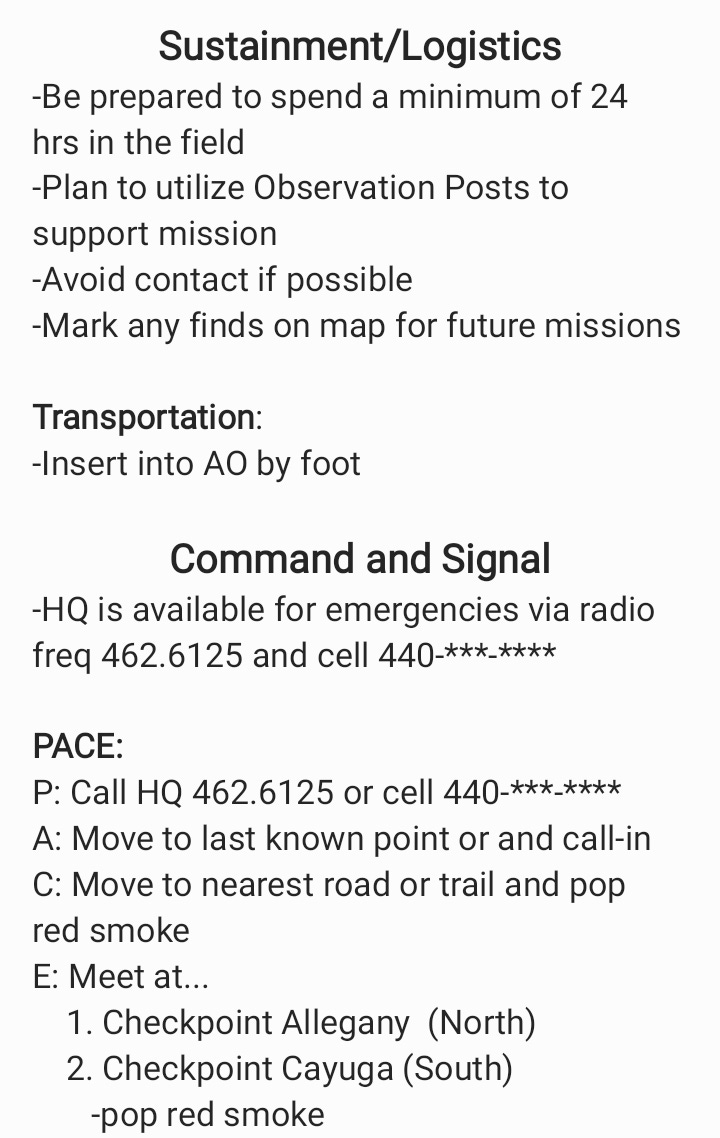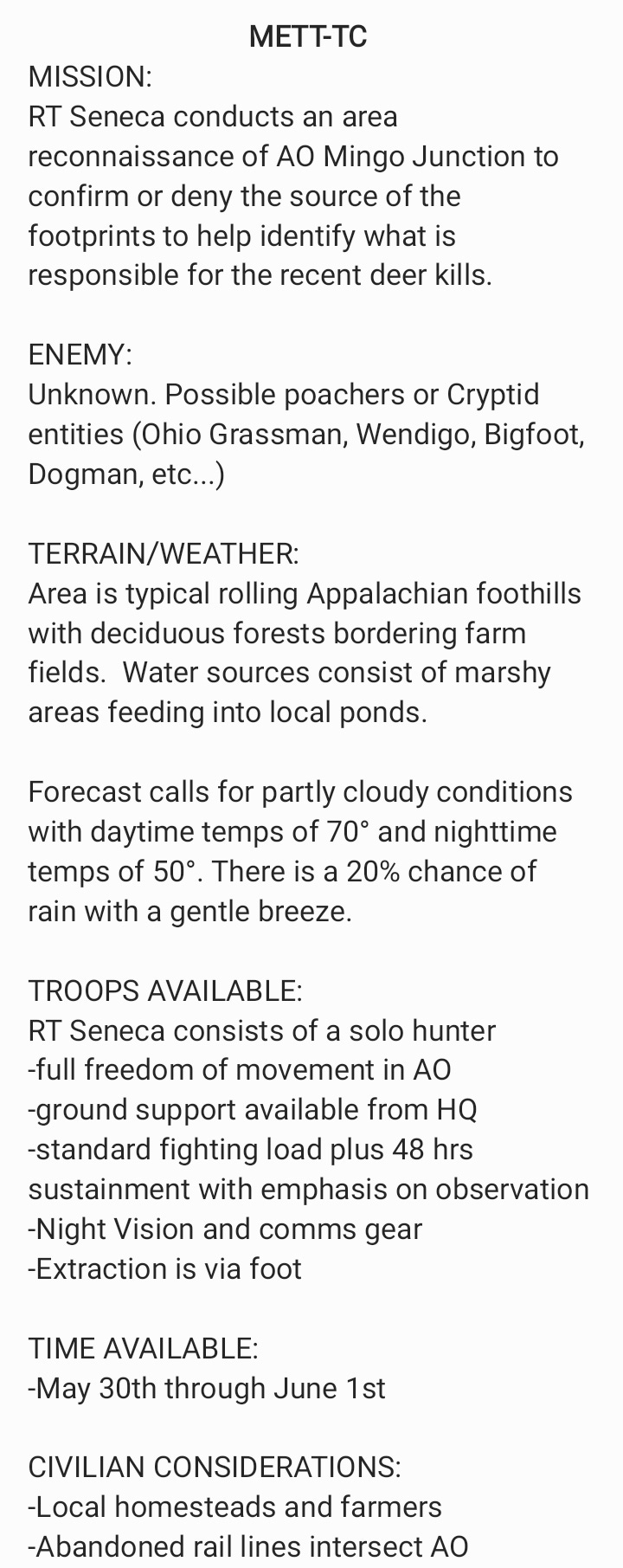You guys who have followed me for the last few years know how much I enjoying putting together “Missions” for weekend FTX’s! It’s a great exercise in planning, logistics, fieldcraft, gear, and more…
Last years “Operation Beer Run” was one such example of one of these “Missions”! I try to do a couple of them a year as part of my training and usually invite a couple of the guys to come participate!
I like to get creative and have a bit of fun with it and this next mission is no different. Ohio has a rich Native American history so I decided to dig into some of their local folklore and discovered the repeated mentioning of Genoskwa or “Stonecoat/Stone Giant” which was claimed to be a larger and meaner cousin of Bigfoot/Sasquatch. It is mentioned amongst many tribes in Ohio specifically the Iroquois and Delaware people. So I decided to run with the idea of mysterious footprints being found along with half eaten deer carcasses along the woodlines of a group of homesteads…
So onto this year my training is focused on getting ready for SERE Challenge and is heavy on planning, observation, and extraction so I started by going through Grunt Proofs article on Patrolling Principles (Please read Grunt Proofs article and go practice it) and set out to develop my own OPORD for the “Mission”…
From Grunt Proofs article:
Whether you’re in a doomsday tactical scenario or simply patrolling the area around your homestead, the principles of patrolling are relevant, and should be applied. Unless you’re just going out for Instagram pictures, a patrol is not just “go out in the woods and walk around looking at stuff.” Even a basic property patrol should include some sort of planning. No, it does not have to be a full blown 5-paragraph Operations Order – a simple 5Ws, “who, what, when, where, why,” and a how, which is your concept of operations, will suffice. So, what are the principles, and how do we apply them?
1. Planning: gathering information, setting objectives, and creating a detailed plan of action. This includes identifying potential threats, establishing routes, and allocating resources (logistics). Effective planning ensures that patrols are conducted with a clear purpose and strategy. Every patrol should serve a specific purpose, and will often lead to further patrols or missions.
Example: you have recently purchased land in a rural area would like to get to know the area around your property. This could become an Area Reconnaissance: you want to identify all the trails in and out of your property, roads nearby, or other civil infrastructure in your area, as well as key terrain in that area. This initial reconnaissance will give you a great deal of intelligence, which will lead to follow on patrols. Next, you may conduct “Route Reconnaissance,” where you will learn more about those trails coming from the National Forest and into your property.
2. Reconnaissance: gathering information about the area to be patrolled. It includes identifying key locations, potential hazards, and points of interest. This information allows patrols to make informed decisions and respond effectively to any situation.
Back to the first example, before you head out for your Area Reconnaissance, you can conduct map reconnaissance on google maps, earth, or your own printed topo map, and already identify a lot of the key terrain in the area you will patrol.
3. Security: This includes maintaining communication, practicing situational awareness, and being prepared for any security threats.
Again with our property patrol: we develop a communications PACE plan with our family or neighbors, and can already begin to develop a Standard Operating Procedure (SOP) for homestead defense and future patrols. “I am going here to do this, and should be back by this time. Unless I call you, if I am not back by this time, you should do this.” You will also be “reconnoitering” dead spots for comms while you are out, as well as testing your skills in mission planning and refining your SOP.
4. Control: maintaining discipline and order during patrols. It involves adhering to the established plan or SOPs, following chain of command, and ensuring that the patrol’s objectives are met. Control is essential for the safety and success of the patrol.
On your property Patrol or Area Reconnaissance, go ahead and practice light, sound, and litter discipline. Practice SLLS – stop, look, listen, smell; Get regular radio checks to rehearse and refine your PACE plan.
5. Common Sense: when working with groups, we encourage patrol teams to use their judgment and make decisions based on the situation at hand. Sounds like we should have a firm understanding of how to apply METTTC, right? While following established SOPs is important, common sense allows for flexibility and adaptability. How are we supposed to update, or refine our SOPs if we don’t even allow people to test them and adapt to begin with?
We begin with the Operations Order (OPORD) – SMESC. This is most likely unnecessary for the average community group, but if you don’t know where to start, this planning matrix helps you identify and organize all the critical information someone should know for a mission: What’s the scenario? What are we doing? How are we doing it? What personnel, toys, and food do we have? Who are we talking to, and how? - just to keep it simple. Believe me, there are people who can debate OPORDs and all the fun variables around a mission for days. Just have a look at the tactical doctrine experts on Instagram. However, having key leaders build them every now and then is great practice. A barebones, clear and concise OPORD for a mission can be built in less than 15 minutes, and briefed to a team in 5 minutes. As long as everyone knows what the desired end state or (the whole point) is, the OPORD is good.
My OPORD is as follows…
Warning Order (WARNO) - usually an abbreviated OPORD for smaller units. They might be for individual missions (patrols) that support the larger, main mission. It also follows the same format as the OPORD. As an example: Defend the Compound and Surrounding area, might be your main OPORD that is 20 pages long and is constantly updated. Your WARNO will be the 5 paragraph for each patrol or mission you conduct to support that OPORD. Therefore, many paragraphs, such as the situation may not need to be changed – in fact, the only paragraph that may change will be the mission. In a smaller group, the WARNO will most likely be your planning tool.
We cannot discuss mission analysis and planning without METT-TC | OAKOC - the absolute bread and butter of decision making. Nearly everything you do from planning to execution is filtered through these Matrices. Use OAKOC for offensive and defensive operations, tactical movements, establishing patrol bases and OPs, providing route security, and nearly every other tactical decision you make.
Now below is the same Mission write up BUT simplified using METT-TC…
Putting these together didn’t really take that much time (especially if you use an existing template) as it is really just plugging in the relevant pieces of information and actions that are needed to take.
Below is the accompanied map put together signifying the different points mentioned in the above OPORD. This much info for a 100 acre area may be overkill, but it makes for good training for planning and execution and easily translates from 100 acres to 3 or 4,000 acres. Practice makes perfect.
As you can see, we have our stepping off point as FOB Da Nang, possible Patrol Base locations (not all have to be utilized, they just happen to be 3 good locations based on prior area surveys, recons, and map intel). I happen to choose locations that would give me a solid spot in the interior and on the edges of the two woodlines that border neighboring homesteads. I also chose two different extraction points as part of my PACE plan. Once again, practice makes perfect. Lessons learned can be applied to the next “mission”.
Now that we have our “mission” planned out we can put together our gear list based upon the needs to have a successful outing. I am planning for 24 to 48 hours of observation in the field so the below list takes that into consideration.
Stay tune for Part 2 which will include an After Action Report next week along with videos from the weekend exercise. We will cover what worked, what didn’t, and how we can improve for the next one. There will be a “Junk on the Bunk” PCC, PCI as we step out from FOB Da Nang, and more in video form.
Thanks for following along!









